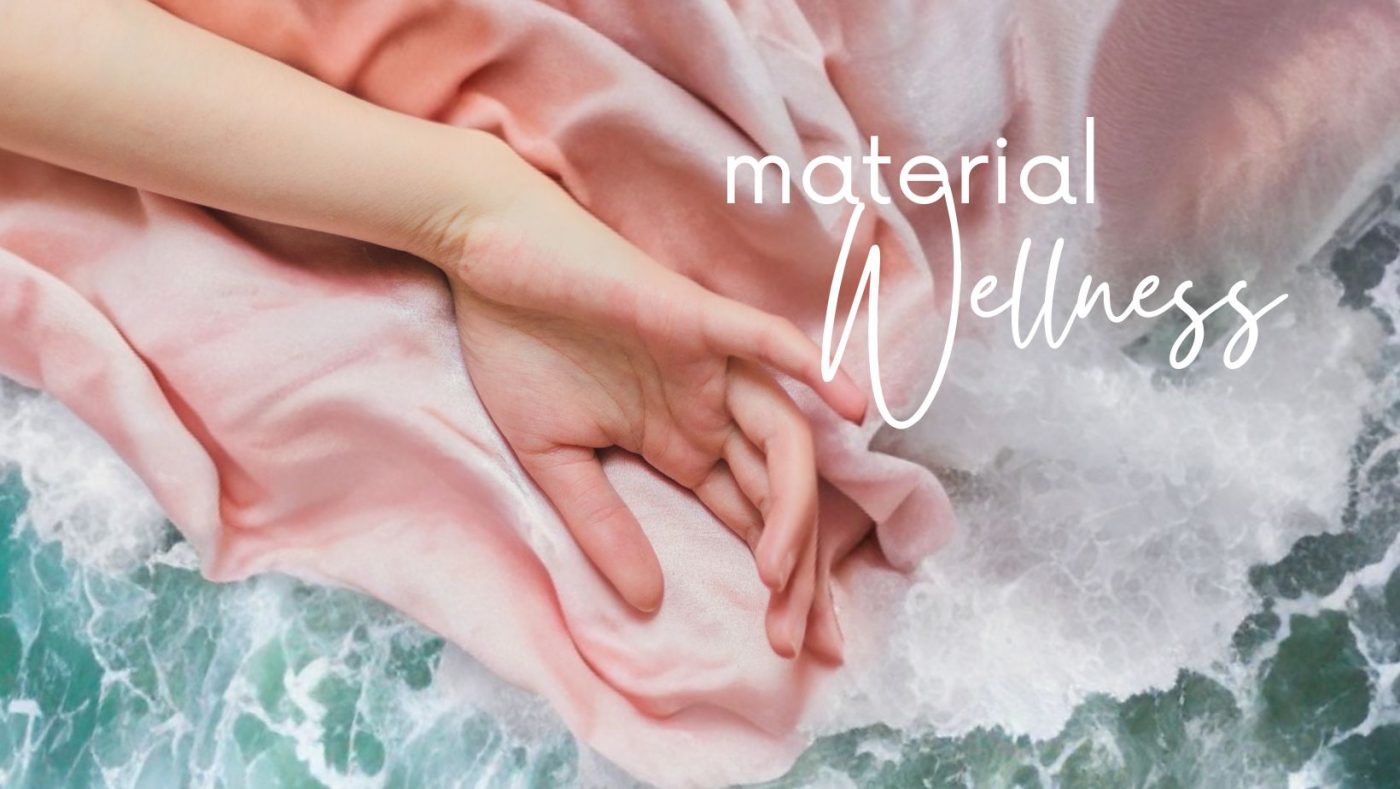Future Conscious, Unspan: Wellness by Design
Worried About Toxins? New Skin Detox Starts In Your Wardrobe.
Did you know that exposure to toxins in many everyday fabrics (like BPA recently found in sportswear and microplastics from polyester) can mess with our hormones, potentially increase the risk of diabetes, heart problems, and liver issues, make it harder for women to have babies, and possibly contribute to skin issues and weight gain?
Consider it Self-Care
Have you ever been so captivated by the softness of a new plushy hoodie or the crispness of freshly laundered bedsheets? Maybe you’ve worn a favourite sweatshirt until it’s threadbare, not because it’s in style, but because it’s the most comfortable thing you own. It’s incredible to think that these everyday fabrics, ones we often don’t give a second thought about, can have such a powerful impact on our comfort, our memories, and more importantly, our health.
Back in 2021 when I first started my deep research on a mission to select the best materials for our fabulous females, I found myself knee-deep in fabric swatches. I was initially drawn to the textures, colours, and patterns, but as I delved deeper, I started uncovering the realities behind each fabric – its production, its journey, and its impact on our bodies. You see, fabrics have silent stories. And some of these stories are ones that the industry would rather keep hushed.
What no one tells you
Your wardrobe preferences affect a lot of things. How you look and feel and how you show up are the obvious outcomes. But how much they affect your health and wellbeing is almost totally overlooked until it’s too late. Like it or not, we are mentally wired to ignore what we cannot see until it accumulates into a bigger problem.
I know so many women who buy expensive organic skin care, diligently follow cleansing rituals and then go and put polyester all over themselves.
Every woman deserves to feel youthful and healthy. Start with awareness – the essentials are here in my research. Understanding the insights can lead to a shift in how you perceive your health and body and a new level of respect and care for your quality of living. It will change your self-esteem and self-worth, I promise. Here is what you need to know.

Toxins get into our bodies with the food we eat, with the air we breathe in and get absorbed through our skin.
Your Skin and The Balance
Your skin is the biggest organ in your body. It is involved in complex thermo-regulating processes, the sense of touch and is home to micro-ecosystems of living things we cannot see.
Just like in the natural world, when we disturb the balance things usually do not go well.
Substances we touch (or put on large areas of our body for days) can get absorbed through our skin and move around our bodies. When those substances involve chemicals and microplastics they can be causing all sorts of havoc. A number of studies also found that our skin can hold onto chemicals for a while before they enter our bloodstream (this process still needs a lot of data to study properly).
And so, my question is what is happening to the skin when toxins accumulate there? And what happens once they get into our bloodstream? I guess, you don’t have to be a scientist to figure that it is not going to lead to a healthy glow…
We know synthetics aren’t ideal, yet a lot of us (and certainly the industry with its cold cost-benefit cynicism) still favour them for their features and price – but what exactly are we compromising?
Polyester
We’ve all been there: standing in a trendy fashion store, entranced by a dress with a stunning design. You look at the price tag – affordable. You glance at the material tag – Polyester. This is the point where we need to pause, step back, and reconsider. Is the stylish design and affordability worth the potential harm you might be doing to yourself and the environment?
Polyester is not a harmless fibre. It is a kind of plastic, a by-product of petroleum. It’s loved by manufacturers for its durability, wrinkle resistance, abundance and price. Yet, this synthetic material is far from benign.
When we look beyond the softness of our polyester clothing, the reality is plain scary. One unsettling fact about polyester is how it releases microplastics. When we wash our clothes, these tiny fibres mix with water and end up in the oceans. In fact, polyester clothing is the 4th biggest source of micro-plastic pollution. And disturbingly, some studies found that the shedding of microplastics triples when we wear these clothes.
These invisible enemies penetrate our surroundings, polluting our air, our food. They are now officially found not just in the oceans (already a known fact) but in soft drinks, salt and … in our bodies.
Even scarier is the fact that this problem is not confined to remote areas – two-thirds of Arctic microplastics came from polyester.
The story gets worse. Studies done with polyester plastics (already seen in mice experiments) have shocking findings and yet this information is reserved for science magazines only.
These microplastics have a knack for absorbing poisonous substances like toxins from detergents, chemicals, and heavy metals. When these microplastics end up in our bodies, which they do, they have the potential to cause significant harm. Research has suggested that these toxins could trigger local immune responses and release toxic elements, leading to neurotoxicity and increased free radical production.
Putting it simply, they make us sick and age us prematurely. Here is the million-dollar question the fashion industry will never ask: “Do you really want this in your socks and underpants?”
And no, adding the word “recycled” does not change the physical or chemical properties of anything, polyester included.

Sweat, Hormones and Your Active Wear
Remember that feeling when you slip into your new yoga leggings or put on that snugly fitted, high-performance sports bra? Activewear is designed to empower us, improve our performance, and make us comfortable during workouts. Is it?
The polyester-based performance fabrics with spandex that make your sportswear breathable, stretchable, and durable are often laced with harmful chemicals. So often that the Center for Environmental Health (CEH) issued a warning about the chemical bisphenol A (BPA) in socks, sports bras, and athletic shirts and sent legal warnings to 100+ brands including industry leaders.
What is so bad about BPA? Well, it is one of the better-known endocrine-disrupting chemicals. BPA mimics the hormone estrogen, which confuses our endocrine system and causes disruption of its normal functions. Consequences? Changes to the way our cells normally function and multiply, the natural cycles of the body, as well as anxiety, depression, and hyperactivity.
Ironic? You bet.
Although BPA is the most well-known bisphenol, there are dozens of other bisphenols (often called BPA replacements) out there that are chemically similar to BPA and cause similar adverse health effects.
You might ask, “If BPA is so widespread, can it be that harmful?” Brace yourself for the unpleasant truth. BPA exposure has been linked to a host of severe health implications such as hormonal disruptions, reproductive disorders, increased risk of cancer, and cardiovascular diseases. We know for sure that phthalates and BPA affect reproduction in all studied animal groups and impair development in crustaceans and amphibians.
The scary part? When we sweat, which is a given during exercise, the absorption rate of BPA into our skin potentially increases.
Each sprint, every yoga pose, and every weight you lift might be accompanied by an unwanted dose of BPA.
Studies have shown that BPA can be absorbed through your skin and end up in the bloodstream after handling receipt paper for seconds or a few minutes at a time. Imagine having it on your skin for hours at a time.
Think about that the next time you slide into your polyester-spandex-laden brand-name leggings.

Your Health is in Your Hands
As a creator in the holistic fashion space, I often find myself at odds with big-name brands. Their deep-pocket marketing campaigns cleverly brand products as “eco-friendly,” even when they’re far from it. It’s a little bewildering how they manage to stay within legal parameters.
Brand messages are often been beautifully deceptive. They charm us with vibrant colours, interesting textures, trendy designs and fluffy comfort. Even more – we’ve all seen the words ‘recycled’, ‘eco-friendly’, and ‘sustainable’ branded across clothing tags and advertisements. It’s a genius move, really.
What they don’t disclose is that recycling doesn’t change the composition of the fabric. The same potentially harmful substances we’ve been discussing? They’re still there. This ‘green’ material is merely the wolf of chemical fabric in the sheep’s clothing of ‘recycled’ labels.
This isn’t even a secret. The knowledge that recycled fabric carries the same chemicals is a universally known fact. It’s like we’ve been told there’s a hole in our pockets, and yet we’re surprised when our change keeps falling out.
So here it is. To be truly conscious, we need to factor in not just the “environment” and social factors but also our own personal health. Then we can start calling it sustainable.
Besides, what’s the point of having a fantastic-looking garment if it’s detrimental to your health? But that’s exactly what’s happening in the clothing industry today. The consideration is primarily for profit margins and aesthetic appeal, with health and long-term impacts seeming to be an afterthought for compliance or marketing.
And so, it is up to the consumers to know what is good for them and vote with their wallets for better choices. Are you ready to take your wellbeing in your own hands?

Non-Toxic Fabrics
Navigating Your Textiles and Making Healthier Choices
Health is wealth. The good news is that wellness properties found in certain fabrics can be working in harmony with your body, not against it. We all inherently know what’s good for us, including the fabrics we choose. However, the overwhelming choices and constant innovations can make things confusing.
It really comes down to the three essentials: understanding the fibres, ensuring organic origins, and checking for non-toxic certifications.
1. Healthy Fibres
Ready to switch to healthier textiles? Choose fabrics made of natural or regenerated natural fibres. Prioritise garments made from organic materials.

Natural Fibres
Breathable, body-friendly, and biodegradable
COTTON
Highly breathable and hypoallergenic, cotton is soft on your skin and highly absorbent.
WOOL
A natural insulator and moisture wicker that adjusts according to body temperature, known for its warmth and resilience
HEMP
Durable, breathable, naturally antimicrobial with excellent UV resistance, softens over time ensuring long-lasting comfort
LINEN
Derived from the flax plant, renowned for its durability and breathability with unique texture, becomes softer with every wash, and helps keep the body cool and fresh
SILK
Offers an indulgent feel with hypoallergenic properties, is perfect for sensitive skin, is naturally breathable, and can keep you cool in summer and warm in winter
Regenerated Natural Fibers
Ultra-soft, breathable, and biodegradable, skin-loving and more sustainable alternative to both synthetic and natural textiles
Lyocell/Tencel
Produced from wood, very soft, absorbent, and very strong when wet or dry, cellulose fibre is regenerated with non-toxic chemicals in a closed-loop process
tanboocel/BAMBOO
Produced from bamboo, ultra-soft, breathable, and possesses natural anti-static, UV-resistant and antibacterial properties. Bamboo fibre is processed with traditional chemicals in a closed-loop process. See more in Moso Morrow fabrics.
Modal
Produced from wood, softer and more durable than cotton, its moisture-wicking properties can help to keep skin dry and reduce discomfort and irritation. It is also resistant to shrinkage and fading, increasing the lifespan of garments.
Viscose/Rayon
Produced from wood, soft, lightweight, and drapes well, created as an alternative to silk and has a shiny texture, not as strong when wet, produced with traditional chemicals
2. Organic Origins
Organic production takes this a step further by eliminating the use of pesticides and chemicals during growth and harvest.
To be sure of the claims look for Global Organic Textile Standard (GOTS) certification or Organic Content Standard (OCS). These are the leading certifications for organic textiles.
GOTS-certified products must contain at least 70% organic fibre content, and the remaining 30% must also meet stringent environmental and social standards.
Only material from certified organic farms (under one of IFOAM’s Family of Standards) is accepted to the OCS. OCS 100 means 100%-organic content, OCS Blended will verify the % of organic content.
Organic certification is only applicable to natural fibres. Regenerated fibres do not have organic certification even if the cellulose comes from organically grown sources due to the use of chemicals in their production. They should come with the “free of the toxic substances” certification instead.
3. Non-toxic Certification
Even with natural and regenerated fibres, the final product’s health benefits can be affected by other factors, such as the particulars of the farming and production process, including regeneration techniques, dyes, finishes, or blending with other fibres.
How will you know it is safe? Always check for certifications like OEKO-TEX to ensure the finished fabric is safe. Avoid garments labelled as “wrinkle-free” or “permanent press”. These often contain formaldehyde, a potential carcinogen.
OEKO-TEX Standard 100: This certification ensures that every component of an item has been tested for harmful substances. It is an independent certification system for raw, semi-finished, and finished textile products at all processing levels.
Healthier does not automatically mean “sustainable”
As I only focused on the wellness aspect and toxins often present in fabric choices, it does not actually mean that the choices that are healthier for you are also healthier for the planet. or that they are produced in a more ethical way than their polyester counterparts.
Seek out brands committed to sustainability and transparency. Though I have not touched on sustainability and ethical production however such commitment often translates to safer, healthier products.
I personally apply this research and knowledge when creating our fabrics and making material choices, and, I’m sure, there are lots of other companies that do too, at least for some of their ranges. Sadly, not everyone is telling the truth, and so, you don’t have to take anyone’s word for it. Fabric composition and certification will not lie as they are legally required to be true facts.
Just CHECK THE LABEL or THE MATERIALS SECTION of each product in online stores.
Your Skin. Your Health. Your Choice.
Here’s where I dug up the facts and figures for this article (the most relevant only, there is also a lot of summarised information that is a combination of my two-year-long research of modern fibres used for fabric production):

